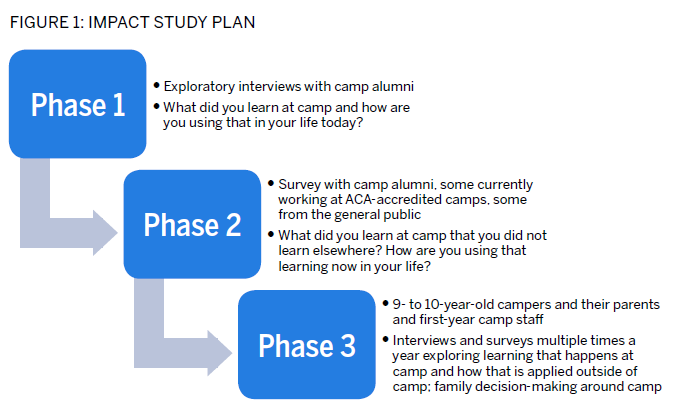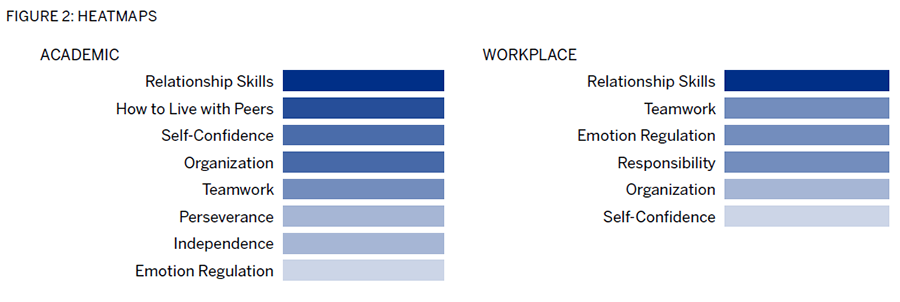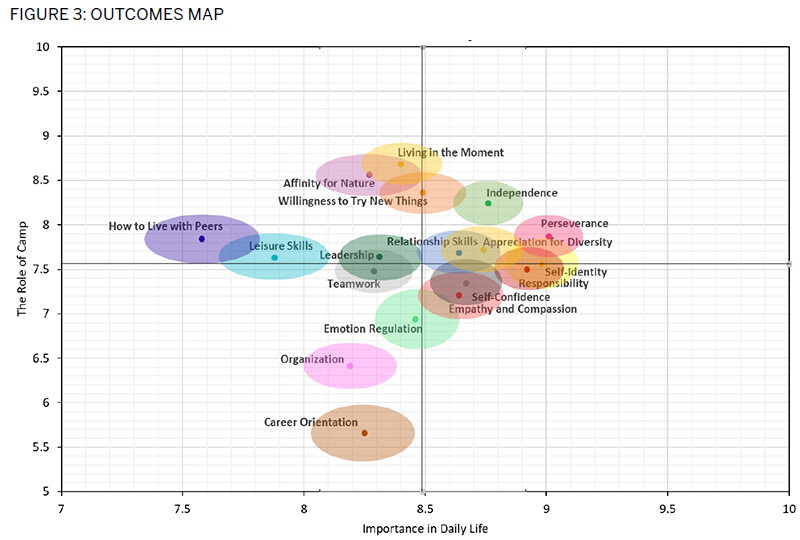It doesn’t take a scientist to explain the impact of camp. If you are reading this, you are likely a camp professional, and if you are a camp professional, you likely see the impact of camp every single day in the campers and staff with whom you work. Some of you might even know the impact of camp because you attended camp as a kid, and you see how the things you learned at camp help you in your adult life.
It might not take a scientist to tell you these things, but it takes science to understand exactly how we can design and implement the highest-quality camp programs, and science is a powerful way to advocate for camp to people who do not fully understand camp’s benefits — parents, funders, educators, and policy makers. Science allows us to demonstrate, in strong and reliable ways, what so many of us already know: The impact of camp lasts a lifetime.
This article is the first of a five-article series focused on a new scientific study conducted by the American Camp Association (ACA) and its research partners. Over the next five issues, we will unpack what we are learning from campers, staff, parents, and camp alumni about the lasting impacts of camp, and we will ask camp professionals from across the country to help translate the findings into research you can use to design camp programs, train staff, and advocate for camp to broad audiences.
Before we can dive into the findings, we need to understand the purpose and scope of this research study. Described here are the research questions and how they were determined, and how the research team plans to explore these questions over the course of a five-year study. But first, a little history lesson: What do we know about camp, and what is most critical to know for camps to thrive in the 21st century?
Camp Research — Past, Present, and Future
Camp research is not new; in fact, camp professionals and researchers have been asking questions about the benefits of the camp experience for nearly a century. In that time, studies ranging from very small to very large have shown that camp is a context for positive youth development (Garst, Browne, & Bialeschki, 2011), making camp an important part of a child’s learning landscape (Ozier, 2018).
The first study to document these outcomes on a national scale was ACA’s 2004–2006 Youth Development Outcomes of the Camp Experience, available today in a series of reports entitled Directions, Inspirations, and Innovations. The Directions study focused on understanding camper outcomes related to positive identity; social skills; physical and thinking skills; and positive values and spirituality. Youth who participated in this study reported increased scores in nearly all of these outcomes, and most of the outcomes stayed the same or continued to increase six months after camp. The Inspirations and Innovations studies examined, respectively, the features of the camp experience that support positive youth development and the effects of program improvement processes on camper outcomes.
Since then, camp research has grown considerably. ACA’s Camp Research Forum, which takes place each year at the ACA National Conference, showcases about 20 new research studies, each of which has been selected through a blind peer-review process. Study topics include camper outcomes to staff outcomes; best practices in program design and implementation; and topics related to special populations, camp parents, physical activity, nutrition, and mental, emotional, and social health. Summaries of these studies are available for free.
A new double issue of the Journal of Youth Development focused specifically on camp experiences is also free and available online (jyd.pitt.edu/ojs/jyd/issue/view/42). Like the many studies found in the ACA Research Forum Books of Abstracts, this journal showcases the depth and breadth in camp research, with articles such as "Race-Evasiveness Among Camp Staff" (Perry, 2018) and "The Role of Camp in Shaping College Readiness and Building a Pathway to the Future for Camp Alumni" (Whittington & Garst, 2018). This double issue makes it clear that the concerns facing camps today are many and complex, but there is a growing body of knowledge and evidence that camp professionals can use to support their work.
Despite an increase in the breadth and depth of camp research, big questions remain unanswered. One of these questions is related to the "stickiness" of camp, a term we use loosely to describe the extent to which the benefits of attending camp last over time. Put differently, do the things campers learn at camp last beyond camp? And, if so, how do they use what they’ve learned at camp later in their lives, like in college, in jobs, or in their communities?
Much of what we know about college, career, and young adulthood suggests that social-emotional skills are the keys to success. Social-emotional competencies, according to the Collaborative for Academic, Social, and Emotional Learning (CASEL), include self-management and awareness, responsible decision-making, relationship skills, and social awareness (see casel.org/core-competencies/). Research on social-emotional learning and its importance for young people is clear:
- Social-emotional learning supports academic performance (Durlak, Weissberg, Dymnicki, Taylor, & Schellinger, 2011).
- Social-emotional competence is at the core of college and career readiness (Dymnicki, Sambolt, & Kidron, 2013).
- Social-emotional skills will be increasingly important in the 21st-century labor market (Deming, 2015).
Social-emotional learning is more important now than ever before, and decades of camp research suggests that camps are well positioned to promote social-emotional learning. With this in mind, ACA and its volunteer community set out to determine what we need to know about camps and social-emotional learning to position camps to serve more youth through the highest-quality programming, now and into the future.
ACA’s Impact Study
ACA’s Youth Impact Study is a five-year research project focused on the lasting impacts of camp, particularly those related to social-emotional learning. The research team is exploring these impacts by asking people who attended camp as kids about what they learned at camp and how they are applying it in college, their jobs, and their early adult lives.
To answer these questions, the ACA National Board of Directors first engaged a volunteer task force to define the research questions, and then passed the baton to a second volunteer group, the Research Advisory Committee (ReAC), who selected the research partner and now oversees the project. This process is important to note because it means the research findings will be reliable and protected from our own biases about camp.
The research team at the University of Utah was selected to explore the lasting impacts of camp, which they are doing through a three-phase study involving camp alumni, camp staff, current campers, parents, and older campers/counselors-in-training. Each phase builds on itself so that the researchers can discover new things about the camp experience. Figure 1 (below) shows the plan.
An important point to note about this plan is that the research team is selecting participants from ACA-accredited camps that represent different camp types (overnight and day camps), clientele, programmatic focus, and regional locations. The campers, parents, staff, and alumni who are contacted through these camps are being selected to represent diverse socioeconomic, racial or ethnic, gender, and ability characteristics. By systematically selecting participants, the research team is working to ensure the results are relevant to camps of all types.

What We’ve Learned So Far
The first two phases of the Impact Study were completed in the fall of 2017 and 2018, respectively; the purpose of both phases was to discover what emerging adults between the ages of 18 and 25 learned at camp when they were kids and how it applies to their lives today. The research team also explored what made learning at camp unique from other learning settings, like school or sports, and what happened at camp to foster lasting learning. In other words, what are the unique mechanisms at camp that promote the outcomes that people go on to use in college, in their jobs, and in their lives beyond camp?
The charts shown in Figure 2 (below) are nontechnical "heatmaps" that show the strongest outcomes from the research team’s interviews with camp alumni about what they learned at camp. The outcomes in dark blue were mentioned more frequently by the interviewees; the lighter shades of blue were common across the interviewees but with slightly less strength than the outcomes marked with a darker blue. The outcomes found in the "Academic" chart represent skills the interviewees learned at camp that they described using now in their academic lives — college for some, high school for others. "Workplace" similarly represents the outcomes the interviewees learned at camp that they now use in their early careers.

First, you’ll see that relationship skills represent the strongest outcome on both lists. This is not new — ACA’s first outcomes study found that peer relationships, teamwork, and social skills were key outcomes of the camp experience. What’s new, though, is the notion that these skills not only last over time, but people who attended camp as kids say what they learned at camp about relationship skills is helping them to thrive in school and in the workplace. The same holds for the other outcomes listed, with slight differences between the outcomes that camp alumni use in school and those they use in their jobs. This is exciting news for camps, because we now have at least preliminary evidence that camp learning lasts beyond camp and likely plays a role in college, career, and overall readiness. What’s more, we have a sense of what happens at camp to promote these outcomes, such as:
- Opportunities for experiential learning and living
- Meaningful interactions with camp staff, who are often people campers relate to
- Meaningful interactions with peers, both in small group living and in collaborative activities
- Camp activities that are fun and capture campers’ interests
- Separation from the home environment, which was notable among people who attended overnight camp as children

Phase 2 builds on these themes in two ways. First, the research team used what they learned in Phase 1 to design a survey that would allow them to quantify the lasting outcomes of camp, and, second, they engaged a more expansive sample to explore these themes on a much larger scale. The chart shown in Figure 3 (above) is an "outcome map" that depicts the relative strength of the key outcomes measured by the survey in terms of their importance in the daily lives of the survey respondents and the unique role of camp (compared to other settings, like school or sports) in promoting those outcomes. The numerical values represent the average score for each outcome out of ten.
The colored circles represent the confidence interval of each outcome, which allows us to see how some of the outcomes overlap. "Relationship skills" and "appreciation for diversity," for example, overlap slightly, meaning these outcomes might be more similar than different; same for "leadership" and "teamwork."
Note, also, that the average scores are very high. The data represented in this chart were collected from first-year staff at ACA-accredited camps who attended camp — any camp, not necessarily the camp where they are currently working — for at least three weeks as kids. But the fact that they were currently on staff means these individuals likely had a positive and memorable experience at camp as kids. To address this, the research team collected similar data from a sample of people who attended camp as kids but are not currently working at an ACA-accredited camp (or any camp, for that matter). While there were slight variations in the outcomes between these camp and noncamp samples, the most notable difference was in the overall levels of the scores — the means were somewhat, although not significantly, lower among respondents who were not currently working at camp.
Jim Sibthorp, PhD, research faculty at the University of Utah and lead investigator in the Youth Impact Study, describes his sense of camp and its role in the 21st century based on these preliminary findings: "Camps are great practice settings for social and emotional learning. A place to practice building and maintaining relationships, form identities, and try new things." He further suggests that because camp is a practice setting, it provides youth with an opportunity to wrestle with important processes and gain proficiencies in certain skills that then free up their cognitive capacity later on in life. "Camp may help to accelerate the development."
What to Look for Next
In two short years, ACA and its research partners at the University of Utah have discovered a great deal about the lasting impacts of camp, the ways these impacts translate into college, career, and life readiness, and the things that happen at camp to promote lifelong learning. Much of what we see so far depicts camp as a context for social-emotional learning, which is exciting given the growing interest among schools and employers in social-emotional skills as the key for success in these settings. To better understand what we are discovering about social-emotional learning at camp, we are going to explore four of the camper outcomes that have emerged thus far in the Impact Study:
- Responsibility and independence
- Living in the moment
- Appreciation for diversity
- Relationship skills
Each outcome will be the focus of an upcoming article in Camping Magazine, which, in total, will complete our series dedicated to exploring how camps train staff, design programs, advocate to parents, and secure partnerships to foster these outcomes among their campers. (We will explore the outcomes of the camp staff experience in a later series.) Of particular interest in this series will be the research findings related to each outcome, case studies of camps with specific interest in the outcome, and the ways camps of all types can work to ensure their campers gain one or all of these outcomes during their time at camp and are prepared to use these outcomes to thrive in school, in their careers, and throughout their lives. Stay tuned over the next several magazine issues as we hear directly from camps and learn from them and the new science that demonstrates the important ways camp lasts a lifetime.
Photo courtesy of Rainbow Trail Lutheran Camp, Hillside, Colorado.
References
- Deming, D. (2015). The growing importance of social skills in the labor market. National Bureau of Economic Research. Retrieved from nber.org/papers/w21473.pdf
- Durlak, J. A., Weissberg, R. P., Dymnicki, A. B., Taylor, R. D., & Schellinger, K. B. (2011). The impact of enhancing students’ social and emotional learning: A meta-analysis of school-based universal interventions. Child Development, 82(1), 405–432.
- Dymnicki, A., Sambolt, M., & Kidron, Y. (2013, March). Improving college and career readiness by incorporating social and emotional learning. Washington, DC: College & Career Readiness & Success Center at American Institutes for Research.
- Garst, B. A., Browne, L., & Bialeschki, M. D. (2011). Youth development and the camp experience. New Directions for Youth Development, 130, 73–87.
- Osher, D., Kidron, Y., Brackett, M., Dymnicki, A., Jones, S., & Weissberg, R. (2016). Advancing the science and practice of social and emotional learning: Looking back and moving forward. Review of Research in Education, 40(1), 644–681.
- Ozier, L. (2018). Learning landscapes: The education spectrum from camps to classrooms. Journal of Youth Development, 13(1–2), 4–13.
- Perry, S. C. (2018). Race-evasiveness among camp staff. Journal of Youth Development, 13(1–2), 14–23.
- Whittington, A., & Garst, B. A. (2018). The role of camp in shaping college readiness and building a pathway to the future for camp alumni. Journal of Youth Development, 13(1–2), 105–125.
Laurie Browne, PhD, is ACA’s director of research. She specializes in ACA’s Youth Outcomes Battery and supporting camps in their research and evaluation efforts. Prior to joining ACA, Laurie was an assistant professor in the Department of Recreation, Hospitality, and Parks Management at California State University–Chico. Laurie received her PhD from the University of Utah, where she studied youth development and research methods.
Rob Warner, a research assistant for ACA, is a doctoral student at the University of Utah and has worked in the youth development field for a variety of organizations as a counselor, field instructor, and mentor.

